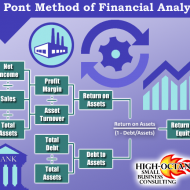Posted by Managementguru in Management Accounting
on Mar 24th, 2015 | 0 comments

What are the advantages and limitations of ratio analysis? Advantages: It is an important and useful tool to determine the efficiency with which working capital is being managed in a business organization. It is a ‘health test‘ for a business firm in that it can gauge whether the firm is financially healthy or not. It aids the management of business concern in evaluating its financial position and performance efficiency. It clearly shows the trend of changes in the market position (upward, downward or static), as it covers a number of previous accounting (financial) periods. The progress or downfall of a firm is clearly indicated by this analysis. It assists in preparing financial estimates for the future (financial forecasting). It facilitates the task of managerial control to a great extent. It helps the credit suppliers and investors in deciding upon a business firm as a potential investment outlet or desirable debtor. Ideal or Standard ratios can be established which can be used as reference points of comparison for a firm’s progress over a period of time. It communicates important information with relation to financial strength, earning capacity, debt (borrowing) capacity, liquidity position, capacity to meet fixed commitments, solvency, capital gearing, working capital management, future prospects etc. of a business concern. This analysis is also useful for bench marking purpose- to compare the working result and efficiency of performance of a business enterprise with that of other firms engaged in the same industry (inter-firm comparison). It helps the management to discharge their basic functions of planning, coordinating, controlling etc. It serves as an instrument for testing management efficiency too. It acts as a useful tool for deciding on certain policy matters. Limitations: Accounting ratios calculated based on ratio analysis will be correct only if the accounting data on which they are based are correct. It is only an analysis of past financial data. In certain cases ratio analysis might prove to be misleading with regard to profits. Continuous fluctuation in price levels ( or, purchasing power of money) seriously affect the validity or comparison of accounting ratios calculated for different accounting periods and make such comparisons very difficult. Comparisons become difficult also on account of difference in the definition of several financial (accounting) terms like gross profit, operating profit, net profit etc. There is lot of diversity in practice as regards to the measurement of ratios. Different firms use different accounting methods and the validity of comparison is severely affected by window dressing in the basic financial statements. A single ratio will not be able to convey much information. This analysis only gives part of the total information required for proper decision-making. This should not be taken as a substitute for sound judgement. It should not be overlooked that business problems cannot be solved mechanically through ratio analysis or other types of financial analysis. Follow ManagementGuru Net’s board Accounting – Financial and Management Accounting on...

Posted by Managementguru in Financial Accounting, Financial Management
on Dec 29th, 2014 | 0 comments

Scope of Financial Management Facebook Buys WhatsApp: Boneheaded or Brilliant? This was the title of a Forbes Article when Mark Zuckerberg acquired Whatsapp for $19 billion dollars, the price that may exceed the GNP of some of those countries. Mark is said to be an unconventional thinker and the WhatsApp acquisition shows Facebook’s determination to follow the road not yet paved. It is a bold move, yet filled with risks along the way. This is one of the finest examples of the big investment decisions of recent times and the right course of action, if you measure the number of potential users of the mobile messaging service rather than the cost of acquiring each user and the potential for selling ads to each user today. Follow these mind blowing tips to become prosperous Picture Courtesy : YoungHstlrs Financial management is one of the important aspects of overall management, which is directly asscoiated with various functional departments like personnel, marketing and production. Financial management embraces wide area with multidimensional approaches. The following are the important scope of financial management. Some of the major scope of financial management are as follows: 1. Investment Decision 2. Financing Decision 3. Dividend Decision 4. Working Capital Decision. 1. Investment Decision: The investment decision involves Risk EvaluationMeasurement of cost of capital andEstimation of expected benefits from a project. Capital budgeting and liquidity are the other two major components of investment decision. Capital budgeting takes care of the distribution of capital and commitment of funds in permanent assets to harvest revenue in future. Capital budgeting is a very focal decision as it impacts the long-term success and growth of a firm. All the same it is a very tough decision because it encompasses the estimation of costs and benefits which are uncertain and unknown. Picture Courtesy: Crowdfundingheroes 2. Financing Decision: Financing decision is related to financing mix or financial structure of the firm. The raising of funds requires decisions regarding Methods and sources of financeRelative proportion and choice between alternative sourcesTime of floatation of securities, etc. In order to meet its investment needs, a firm can raise funds from various sources. Long Term Sources of Finance: Share Capital or Equity SharesPreference Capital or Preference SharesRetained Earnings or Internal AccrualsDebenture / BondsTerm Loans from Financial Institutes, Government, and Commercial BanksVenture FundingAsset SecuritizationInternational Financing by way of Euro Issue, Foreign Currency Loans, ADR, GDR etc. Picture Courtesy: Cash & Treasury Management file Medium Term Sources of Finance: Preference Capital or Preference SharesDebenture / BondsMedium Term Loans fromFinancial InstitutesGovernment, andCommercial BanksLease FinanceHire Purchase Finance Short Term Sources of Finance: Trade CreditShort Term Loans like Working Capital Loans from Commercial BanksFixed Deposits for a period of 1 year or lessAdvances received from customersCreditorsPayablesFactoring ServicesBill Discounting etc. 3. Dividend Decision: In order to accomplish the goal of wealth maximization, a proper dividend policy must be established. One feature of dividend policy is to decide whether to distribute all the profits in the form of dividends or to plough back the profit into business. While deciding the optimum dividend payout ratio (proportion of net profits to be paid out to shareholders), the finance manager should consider the following: Investment opportunities available to the firmPlans for expansion and growth,Dividend stabilityForm of dividends, i.e., cash dividends or stock dividends, etc. 4. Working Capital Decision: Working capital decision is related to the FINANCING in current assets and current liabilities. Current assets include cash, receivables, inventory, short-term securities, etc. Current liabilities consist of creditors, bills payable, outstanding expenses, bank overdraft, etc. Current assets are those assets which are convertible into cash within a year. Similarly, current liabilities are those liabilities, which are likely to mature for payment within...




